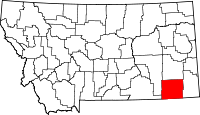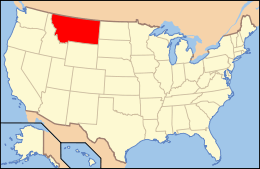Powder River County, Montana
| Powder River County, Montana | |
|---|---|
 Powder River Courthouse in Broadus | |
 Location in the U.S. state of Montana | |
 Montana's location in the U.S. | |
| Founded | 1919[1] |
| Named for | Powder River |
| Seat | Broadus |
| Largest town | Broadus |
| Area | |
| • Total | 3,298 sq mi (8,542 km2) |
| • Land | 3,297 sq mi (8,539 km2) |
| • Water | 0.6 sq mi (2 km2), 0.02% |
| Population (est.) | |
| • (2015) | 1,773 |
| • Density | 0.5/sq mi (0/km²) |
| Congressional district | At-large |
| Time zone | Mountain: UTC-7/-6 |
| Website |
www |
Powder River County is a county located in the U.S. state of Montana. As of the 2010 census, the population was 1,743.[2] Its county seat is Broadus.[3]
History
Present-day Powder River County was probably first entered by Europeans in the early 1800s by French fur trappers. In the summer of 1865, the United States government sent over 2,600 U.S. soldiers to the Powder River Country to combat Native Americans from the Cheyenne, Lakota Sioux, and Arapaho tribes. The column became known as the Powder River Expedition. On September 8, 1865, in present-day Powder River County, it engaged in the Battle of Dry Ford, about 5 miles (8.0 km) northeast of the future site of Broadus.[4] On March 17, 1876, the Battle of Powder River occurred in the south-central part of the county, about 34 miles (55 km) southwest of Broadus.[5] On November 1, 1878, Powderville became the first establishment in the county, as the Powder River Telegraph Station, on the Fort Keogh to Deadwood, South Dakota telegraph line.[6] On April 5, 1879, the Mizpah Creek Incidents began near the Powderville telegraph station in the extreme northern part of the county. In the early 1880s, a large area of Southeastern Montana became Custer County, Montana, including the present area encompassed by Powder River County. In February, 1900, the Broadus post office was established, named after the Broaddus family. In October, 1918, publication of the newspaper, the Broadus Independent, (now called the Powder River Examiner) began in Broadus, and is still published today. In 1919, Powder River County, Montana was formed from southern Custer County, and in an election in 1920, Broadus was chosen as the county seat of the newly established Powder River County.
Geography
According to the U.S. Census Bureau, the county has a total area of 3,298 square miles (8,540 km2), of which 3,297 square miles (8,540 km2) is land and 0.6 square miles (1.6 km2) (0.02%) is water.[7]
Major highways
Adjacent counties
- Big Horn County, Montana - west
- Rosebud County, Montana - west
- Custer County, Montana - north
- Carter County, Montana - east
- Crook County, Wyoming - southeast
- Campbell County, Wyoming - south
- Sheridan County, Wyoming - southwest
National protected area
- Custer National Forest (part)
Demographics
| Historical population | |||
|---|---|---|---|
| Census | Pop. | %± | |
| 1920 | 3,357 | — | |
| 1930 | 3,909 | 16.4% | |
| 1940 | 3,159 | −19.2% | |
| 1950 | 2,693 | −14.8% | |
| 1960 | 2,485 | −7.7% | |
| 1970 | 2,862 | 15.2% | |
| 1980 | 2,520 | −11.9% | |
| 1990 | 2,090 | −17.1% | |
| 2000 | 1,858 | −11.1% | |
| 2010 | 1,743 | −6.2% | |
| Est. 2015 | 1,773 | [8] | 1.7% |
| U.S. Decennial Census[9] 1790-1960[10] 1900-1990[11] 1990-2000[12] 2010-2015[2] | |||
2000 census
As of the census[13] of 2000, there were 1,858 people, 737 households, and 524 families residing in the county. The population density was <1/km² (<1/sq mi). There were 1,007 housing units at an average density of <1/km² (<1/sq mi). The racial makeup of the county was 97.42% White, 1.78% Native American, 0.11% Asian, 0.22% from other races, and 0.48% from two or more races. 0.59% of the population were Hispanic or Latino of any race. 33.2% were of German, 13.8% English, 10.7% Irish and 5.9% Norwegian ancestry.
There were 737 households out of which 30.70% had children under the age of 18 living with them, 64.90% were married couples living together, 4.10% had a female householder with no husband present, and 28.80% were non-families. 24.80% of all households were made up of individuals and 9.90% had someone living alone who was 65 years of age or older. The average household size was 2.48 and the average family size was 2.99.
In the county the population was spread out with 26.60% under the age of 18, 4.80% from 18 to 24, 23.30% from 25 to 44, 26.80% from 45 to 64, and 18.50% who were 65 years of age or older. The median age was 42 years. For every 100 females there were 97.20 males. For every 100 females age 18 and over, there were 95.40 males.
The median income for a household in the county was $28,398, and the median income for a family was $34,671. Males had a median income of $23,971 versus $17,411 for females. The per capita income for the county was $15,351. About 9.90% of families and 12.90% of the population were below the poverty line, including 12.70% of those under age 18 and 16.30% of those age 65 or over.
2010 census
As of the 2010 United States Census, there were 1,743 people, 755 households, and 505 families residing in the county.[14] The population density was 0.5 inhabitants per square mile (0.19/km2). There were 1,022 housing units at an average density of 0.3 per square mile (0.12/km2).[15] The racial makeup of the county was 95.0% white, 1.5% American Indian, 0.2% Asian, 0.1% black or African American, 1.1% from other races, and 2.1% from two or more races. Those of Hispanic or Latino origin made up 1.4% of the population.[14] In terms of ancestry, 34.6% were German, 31.0% were American, 15.1% were English, 14.0% were Irish, and 8.6% were Norwegian.[16]
Of the 755 households, 26.5% had children under the age of 18 living with them, 58.1% were married couples living together, 5.0% had a female householder with no husband present, 33.1% were non-families, and 28.3% of all households were made up of individuals. The average household size was 2.26 and the average family size was 2.76. The median age was 49.3 years.[14]
The median income for a household in the county was $37,685 and the median income for a family was $50,156. Males had a median income of $27,721 versus $26,250 for females. The per capita income for the county was $21,543. About 11.6% of families and 14.1% of the population were below the poverty line, including 15.7% of those under age 18 and 11.7% of those age 65 or over.[17]
Communities
Town
- Broadus (county seat)
Census-designated place
Unincorporated communities
Notable residents
- Lee Randall, current Republican member of the Montana Legislature.
See also
- Fort Howes
- List of cemeteries in Powder River County, Montana
- List of lakes in Powder River County, Montana
- List of mountains in Powder River County, Montana
- National Register of Historic Places listings in Powder River County, Montana
References
- ↑ Powder River County official website
- 1 2 "State & County QuickFacts". United States Census Bureau. Retrieved September 16, 2013.
- ↑ "Find a County". National Association of Counties. Retrieved 2011-06-07.
- ↑ Wagner, David E. (2009). Powder River Odyssey: Nelson Cole's Western Campaign of 1865, The Journals of Lyman G. Bennett and Other Eyewitness Accounts. The Arthur H. Clark Company.
- ↑ Vaughn, J.W. (1961). The Reynolds Campaign on Powder River. University of Oklahoma Press.
- ↑ Powderville: A Personal History.
- ↑ "2010 Census Gazetteer Files". United States Census Bureau. August 22, 2012. Retrieved November 29, 2014.
- ↑ "County Totals Dataset: Population, Population Change and Estimated Components of Population Change: April 1, 2010 to July 1, 2015". Retrieved July 2, 2016.
- ↑ "U.S. Decennial Census". United States Census Bureau. Retrieved November 29, 2014.
- ↑ "Historical Census Browser". University of Virginia Library. Retrieved November 29, 2014.
- ↑ "Population of Counties by Decennial Census: 1900 to 1990". United States Census Bureau. Retrieved November 29, 2014.
- ↑ "Census 2000 PHC-T-4. Ranking Tables for Counties: 1990 and 2000" (PDF). United States Census Bureau. Retrieved November 29, 2014.
- ↑ "American FactFinder". United States Census Bureau. Retrieved 2008-01-31.
- 1 2 3 "DP-1 Profile of General Population and Housing Characteristics: 2010 Demographic Profile Data". United States Census Bureau. Retrieved 2016-01-10.
- ↑ "Population, Housing Units, Area, and Density: 2010 - County". United States Census Bureau. Retrieved 2016-01-10.
- ↑ "DP02 SELECTED SOCIAL CHARACTERISTICS IN THE UNITED STATES – 2006-2010 American Community Survey 5-Year Estimates". United States Census Bureau. Retrieved 2016-01-10.
- ↑ "DP03 SELECTED ECONOMIC CHARACTERISTICS – 2006-2010 American Community Survey 5-Year Estimates". United States Census Bureau. Retrieved 2016-01-10.
 |
Custer County |  | ||
| Big Horn County and Rosebud County | |
Carter County | ||
| ||||
| | ||||
| Sheridan County, Wyoming | Campbell County, Wyoming | Crook County, Wyoming |
Coordinates: 45°23′N 105°38′W / 45.38°N 105.64°W